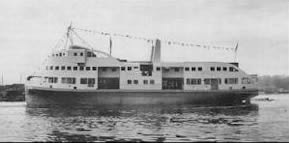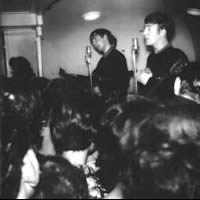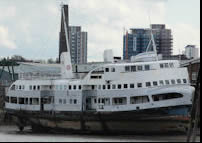References:-
Mersey Ferries - Volume 1 by T.B Maund & Martin Jenkins
The Rise & Progress of Wallasey by by E.C.Woods & P.C.Brown
Almost An Island - The Story of Wallasey by Noel E. Smith
 |
Twin Screw Motor Vessel (T.S.M.V) ''Royal Iris' was launched on 5th December, 1951 and was the first of the new diesel electric twin-screw vessels that entered service on the Mersey. She is the first vessel specially designed for the dual purpose of cruising and ferrying. The Royal Iris was built by William Denny & Brothers of Dumbarton, who, in 1826, had built the 'Sir John Moore', the first paddle steamer to ferry passengers for James Atherton from New Brighton in 1834. The engines of the Royal Iris were produced by Rushton & Hornby Metropolitan-Vickers which gave her a maximum speed of 12 knots. The diesel ferry electric ferry proved very economical, a survey after the first four years of her service showed a saving of £25 per day compared with the older steam vessels. The weight of the Royal Iris is 1,234 gross tonnes and she measured 159 feet long and 48 feet wide, with a draught of 9 feet. Total cost of building the vessel amounted to £400,000 and she was designed by the General Manager of Wallasey Ferries, Commander L.D Price and his Deputy, Mr O. Davidson.
The Royal Iris entered service on 5th May, 1951 after being delivered to the Wallasey Corporation a month earlier. She was licensed to carry 2,296 passengers on normal ferry duties or 1,000 for cruising. Painted in a green and cream livery, the ship was distinctive in having a forward dummy tunnel near her bridge and two exhaust stacks amidship, on both sides. Onboard entertainment included a ballroom measuring 60 x 40 feet, licensed bars, a cocktail bar and snooker room. There was also a fish and chip saloon which soon gained her the nickname 'the fish and chip boat'.
Within weeks of the launch of the Royal Iris the Liverpool Police were involved after a report of out of hours drinking and rowdy behaviour. Chief Inspector Seymour Jones and other members of the force decided to go on a cruise in plain-clothes and mix with the people on board. They noted that drinks were being served from the bar after 3 p.m. The Chief Inspector waited for an hour before heading for the Captain's cabin accompanied by his sergeant. Under the assumption that the Captain of the Royal Iris would be the licensee, Jones knocked at the door of the cabin and entered. The Captain was annoyed at the way the police barged their way into his cabin and so, as master of the ship, he used his maritime right to have the Chief Inspector arrested and locked him in the cabin. In fact the licensee was not the Captain of the Royal Iris but in fact the Chief Steward. When the boat returned, the captain let the police officer out of his cabin.
The case went to court and was heard in March 1952. The Stipendiary Magistrate, Arthur McFarland, said that the sale of drinks on board must be covered by the 1921 Licensing Act. Later it was ruled by Lord Goddard who said that the sale of intoxicating liquor on the pleasure boats on the River Thames did not fall under the 1921 Act. On hearing this, Wallasey Corporation told the ferry boat captain to serve drinks to their passengers outside the hours, while the boats were afloat. The news had been covered by the National press with such headlines as "Ferry Captain held Inspector in Cabin".
At 10pm on 7th September, 1951, the battleship HMS Duke Of York, which had seen action in World War II, was under tow on her way to being broken up at Gareloch when she collided with the Royal Iris off Gladstone Dock, Bootle. The Royal Iris had just finished a 3 hour cruise which had been organised by the Amalgamated Engineering Union. The Royal Iris went temporarily out of control and she was carried by the flood tide against >>>
the battleship. Royal Iris was damaged about the superstructure. Over 60 people were injured, most of them superficially. The Royal Iris called at Liverpool, where three people were taken to hospital for treatment and then she crossed the river to Seacombe Stage where a fleet of ambulances and taxis took over 60 people to hospital - only 10 were detained.
 It was during the 1960's that the Royal Iris reached her peak as numerous acts, some associated with Liverpool's 'Mersey Beat' scene, performed on the ferry. Acts such as The Beatles played on the Royal Iris on 25th August 1961 and made three further appearances in July, August and September the following year. Other acts that also played on the Royal Iris was Acker Bill and Gerry & The Pacemakers, who went on to release the 1965 hit, 'Ferry Cross The Mersey'.
It was during the 1960's that the Royal Iris reached her peak as numerous acts, some associated with Liverpool's 'Mersey Beat' scene, performed on the ferry. Acts such as The Beatles played on the Royal Iris on 25th August 1961 and made three further appearances in July, August and September the following year. Other acts that also played on the Royal Iris was Acker Bill and Gerry & The Pacemakers, who went on to release the 1965 hit, 'Ferry Cross The Mersey'.
From 1st December, 1969, the passenger transport services of Liverpool, Birkenhead and Wallasey Corporation, were taken over by the 'Merseyside Passenger Transport Committee' (MPTE). The Royal Iris transferred to the combined fleet which included seven other ferry vessels - notably from Birkenhead :- 'Mountwood', 'Woodchurch' and 'Overchurch'.
With falling passenger numbers, due in large with the opening of the Wallasey Kingsway tunnel which meant visitors could drive to New Brighton instead of using the ferry and the closure of the New Brighton ferry stage, the Royal Iris found herself in increasing debt. Revenue was made available to refit her at the Harlard & Woolf shipyard in 1971-1972. She was given a new blue and white livery and was subsequently used, almost exclusively, as a cruise vessel;. On 12th January, 1975, whilst being surveyed, a fire broke out in the engine room, causing extensive electrical damage. Also damaged were many internal fittings and it was necessary to replace the carpets on the main deck.
In the Summer of 1979 the Royal Iris was used by Granada Television as a setting for the ITV Saturday morning children's television series 'The Mersey Pirate', which featured Dougie Brown and Billy Butler. Andrew Schofield and Ray Kingsley also stared, who went on to star in the 1984 comedy 'Scully'. 'Mersey Pirate' eventually sunk without warning. In August 1979, ITV staff downed tools and the network went off air for a few months (except in the Channel Islands). ITV eventually returned in November, Rather than decide to issue a second series of the Mersey Pirate, replete with technical problems, Granada opted for a studio-bound affair - the Fun Factory.
In 1985 the Royal Iris sailed to London where she was used for the campaign for the retention of Merseyside County Council. The Royal Iris sailed up the Thames where she moored as close to Westminster as she could, emblazed with suitable slogans. However, the County Council was abolished in 1986.
 |
During the early 1990s, Mountwood, Woodchurch and Overchurch underwent extensive refurbishment, which included provision for cruising duties. The ageing Royal Iris, the last ex-Wallasey vessel, was considered surplus to requirements. She was sold in 1993 to a consortium for conversion into a floating nightclub, based in Cardiff. This venture ultimately did not come to fruition. Since 2002 the vessel has been laid up on the River Thames awaiting a possible refit as a floating nightclub.
References:-
Mersey Ferries - Volume 1 by T.B Maund & Martin Jenkins
The Rise & Progress of Wallasey by by E.C.Woods & P.C.Brown
Almost An Island - The Story of Wallasey by Noel E. Smith